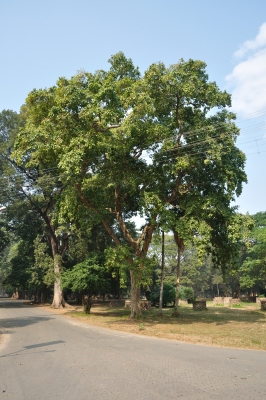Mitragyna parvifolia
(Roxb.) Korth.
Rubiaceae
Nauclea parvifolia Roxb.
Nauclea parvifolia Willd.
Stephegyne parvifolia (Roxb.) Korth.
Common Name: Kaim

Cultivated tree at the Acharya Jagadish Chandra Bose Indian Botanic Garden in Calcutta
Photograph by: Biswarup Ganguly
Creative Commons Attribution 3.0

Cultivated tree at the Acharya Jagadish Chandra Bose Indian Botanic Garden in Calcutta
Photograph by: Biswarup Ganguly
Creative Commons Attribution 3.0

Leaves with young growth
Photograph by: Vinayaraj
Creative Commons Attribution-Share Alike 3.0

Fruiting branch
Photograph by: J.M.Garg
Creative Commons Attribution-Share Alike 3.0


General Information
Mitragyna parvifolia is a deciduous tree growing up to 27 metres tall[
].
The tree is harvested from the wild - it yields a valuable timber and has local medicinal uses.
Known Hazards
None known
Botanical References
Range
E. Asia - India, Sri Lanka, Nepal, Bangladesh, Myanmar, Andaman and Nicobar Islands.
Habitat
Deciduous forests, at elevations up to 1,300 metres in the Himalayas[
146- Title
- A Manual of Indian Timbers.
- Publication
-
- Author
- Gamble. J. S.
- Publisher
- Bishen Singh Mahendra Pal Singh
- Year
- 1972
- ISBN
- -
- Description
- First written in the 19th century, but still a classic, giving a lot of information on the uses and habitats of Indian trees. Not for the casual reader.
,
].
Properties
| Medicinal Rating |      |
| Other Uses Rating |      |
| Habit | Deciduous Tree |
| Height | 20.00 m |
| Cultivation Status | Wild |
Cultivation Details
A plant of the tropics, where it is found at elevations up to 1,300 metres. It grows best in areas where annual daytime temperatures are within the range 20 - 35°c, but can tolerate 5 - 47°c[
]. When dormant, the plant can survive temperatures down to about -5°c, but young growth can be severely damaged at -1°c[
]. It prefers a mean annual rainfall in the range 1,500 - 2,500mm, but tolerates 900 - 3,300mm[
].
Young trees withstand shade, whilst older trees are light demanding[
]. Succeeds in wide range of fertile soils[
]. Prefers a pH in the range 5.5 - 6.5, tolerating 4.5 - 7.5[
].
The tree reproduces very sparingly in the wild, but better where the soil has been broken up so that the small seeds can reach the ground without difficulty[
146- Title
- A Manual of Indian Timbers.
- Publication
-
- Author
- Gamble. J. S.
- Publisher
- Bishen Singh Mahendra Pal Singh
- Year
- 1972
- ISBN
- -
- Description
- First written in the 19th century, but still a classic, giving a lot of information on the uses and habitats of Indian trees. Not for the casual reader.
].
The flowers are very fragrant[
372- Title
- Flowers of India
- Publication
-
- Author
-
- Website
- http://www.flowersofindia.net/
- Publisher
-
- Year
- 0
- ISBN
-
- Description
- A wed site of native Indian plants, plus cultivated and naturalized species. It has good quality photos and terse details on more than 3,000 species and cultivars.
].
Edible Uses
None known
Medicinal
The bark and roots are used in the treatment of fevers and colic[
240- Title
- Glossary of Indian Medicinal Plants (Including the Supplement).
- Publication
-
- Author
- Chopra. R. N., Nayar. S. L. and Chopra. I. C.
- Publisher
- Council of Scientific and Industrial Research, New Delhi.
- Year
- 1986
- ISBN
- -
- Description
- Very terse details of medicinal uses of plants with a wide range of references and details of research into the plants chemistry. Not for the casual reader.
].
Other Uses
The light pinkish-brown wood is even-grained, moderately hard and durable if not exposed to the wet[
146- Title
- A Manual of Indian Timbers.
- Publication
-
- Author
- Gamble. J. S.
- Publisher
- Bishen Singh Mahendra Pal Singh
- Year
- 1972
- ISBN
- -
- Description
- First written in the 19th century, but still a classic, giving a lot of information on the uses and habitats of Indian trees. Not for the casual reader.
]. It is easily worked and polishes well. A useful wood, esteemed for many purposes, it is used in construction, furniture making, agricultural implements, combs, cups, spoons, plates and for turned and carved articles[
146- Title
- A Manual of Indian Timbers.
- Publication
-
- Author
- Gamble. J. S.
- Publisher
- Bishen Singh Mahendra Pal Singh
- Year
- 1972
- ISBN
- -
- Description
- First written in the 19th century, but still a classic, giving a lot of information on the uses and habitats of Indian trees. Not for the casual reader.
].
Propagation
Seed. The plant is difficult to propagate in the nursery[
146- Title
- A Manual of Indian Timbers.
- Publication
-
- Author
- Gamble. J. S.
- Publisher
- Bishen Singh Mahendra Pal Singh
- Year
- 1972
- ISBN
- -
- Description
- First written in the 19th century, but still a classic, giving a lot of information on the uses and habitats of Indian trees. Not for the casual reader.
].
If you have any useful information about this plant, please leave a comment. Comments have to be approved before they are shown here.






 Useful Tropical Plants Database 2014 by
Ken Fern,
web interface by
Ajna Fern
with help from
Richard Morris.
Useful Tropical Plants Database 2014 by
Ken Fern,
web interface by
Ajna Fern
with help from
Richard Morris.